Florida's Lizards
Exotic lizards in Florida currently outnumber native lizards by 3 to 1, with about 48 non-native species having been introduced to the state through the pet trade as escapees and intentional releases or as stowaways in items imported from other countries. As with many exotic plant and animal species that end up in Florida's ecosystems, imported lizards and other reptiles and amphibians pose serious threats to the native species.
Carolina Anole, Brown Anole, Northern Curly-tailed Lizard, Florida Scrub Lizard, Green Iguana, Five-lined Skink, Agama Lizard, Island Glass Lizard, Brown Basilisk, Tropical House Gecko, Argentine Black and White Tegu
Carolina Anole, Green Anole - Anolis carolinensis
Native
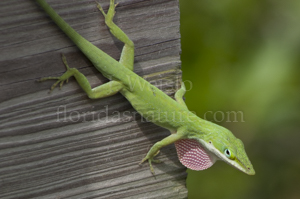
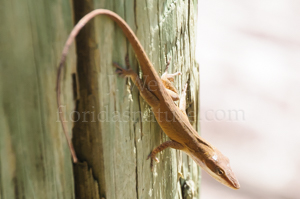
Found throughout Florida, the Carolina Anole is the only anole species native to the United States. Adults are 4-8 inches long with a slender body and a narrow pointed head. The head has ridges that extend from the eyes to the nostrils.
Males have a red "dewlap" that they extend when trying to attract females or when confronting another male, this is usually accompanied with bobbing the head up and down. The Carolina Anole is able to change color from shades of brown to bright emerald green as a means of camouflage. Diet includes small insects such as crickets, flies, mosquito and spiders. This lizard is generally arboreal in nature.
Brown Anole, Cuban Anole - Anolis sagrei
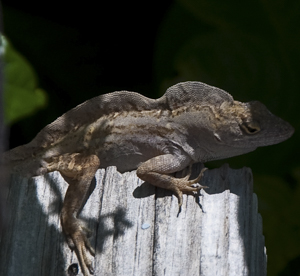
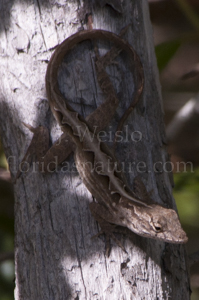
Invasive / Exotic
Brown anole adults are 5 - 8.5 inches long, and brown to grayish in color usually with a white/to yellowish roughly diamond shaped pattern on its back. Adult males have an orange or red dewlap with a white edge. Diet consists of a variety of insects and spiders. Brown anole are usually found on the ground or in low vegetation this lizard lives in a variety of habitats where it competes with native species for food and space.
Northern Curly-tailed lizard - Leiocephalus carinatus
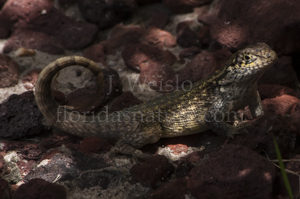
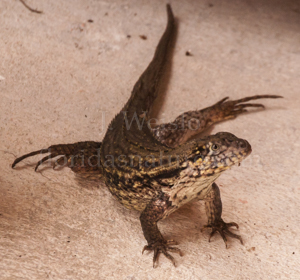
Invasive / Exotic
Introduced into Palm Beach county in the 1940s in a failed attempt to control sugar cane pests. It has since decimated the native lizard populations as it preys upon Anoles and will eat just about anything including human left-overs and pet foods.
This heavy bodied lizard grows to about 10 inches in length, far out weighing native Florida species. Primarily terrestrial, Northern curly tailed lizards are also omnivorous having been observed consuming both fruits and flowers.
Florida Scrub Lizard - Sceloporus woodi
Native

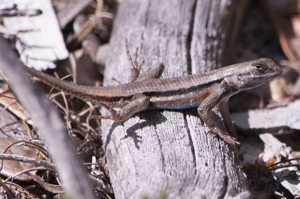
The Florida scrub lizard is a gray or gray-brown lizard sometimes having a slight reddish hue with adults reaching 5 inches in length. A prominent characteristic of scrub lizards is a thick brown stripe that runs down each side of the body from the neck to the base of the tail.
Scrub lizards are habitat specialists that live in dry uplands such as scrub, sandhill, and scrubby flatwoods. They require sunny areas with large amounts of bare sand adjacent to shrubs or trees that provide safe hiding places and shade. Their diet consists of insects, spiders and even other small lizards. Scrub lizards generally do not move through dense vegetation and are unlikely to move between open sandy patches unless they are no more than a few hundred meters apart and connected by open areas.
Green Iguana - Iguana iguana
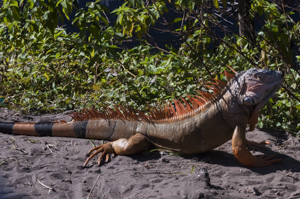

Invasive / Exotic
Green iguanas can grow to over five feet in length, males weigh up to 17 pounds. Females usually do not exceed seven pounds. Typically green lizards, they can sometimes be brown or almost black in color, adults may also take on an orange or pink coloration during certain times of the year.
Green iguanas feed on a wide variety of vegetation, including shoots, leaves, blossoms and fruits of plants. Adult green iguanas sometimes feed on bird eggs and dead animals.
Southeastern Five-lined Skink - Plestiodon inexpectatus
Native

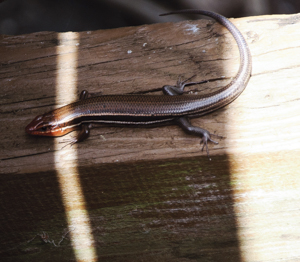
5 - 8.5 inches long, black body when young with five white or yellowish stripes, as an adult the body turning brown to reddish brown especially in the head and throat area. Juveniles have a bright blue to purple-ish tail resulting in the common name of "Blue-tailed lizards".
The Southeastern Five-lined Skink prefers forested areas hiding and hunting around and under tree bark, old fallen trees and logs or leaf litter for a wide variety of insects and spiders that make up its diet.
Agama Lizards
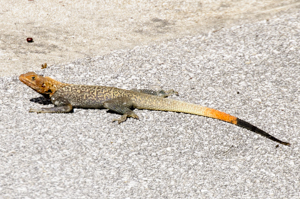
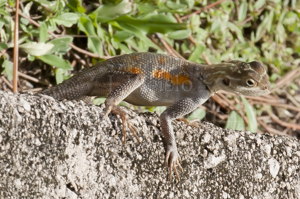
Invasive / Exotic
Pictured above - Agama picticauda (L) Male (R) Female
First found in Florida in 1976, the family Agamidae has roughly 500 known species native to Africa, Asia, Australia, and Europe. There are four species of Agamid lizards with established populations in Florida, Peter's Rock Agama is the most widespread of these four.
Adult males grow to 12 inches, females are a bit smaller. Adult males in breeding coloration have a bright orange or red head, black body, with an orange and black tipped tail. subordinate males are duller with a grayish back. Females are a drab brownish grey with light green spots and stripes on the head and neck area, females with eggs have yellow or orange patches on their sides. Juveniles are similar to females in appearance.
In Florida the Agamas diet consists of crawling insects, they have been seen chasing flying insects as well and quite possibly consume other, smaller lizards.
Island Glass Lizard - Ophisaurus compressus
Native
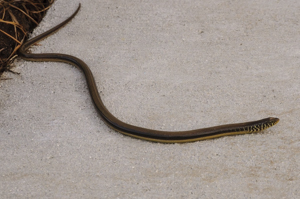
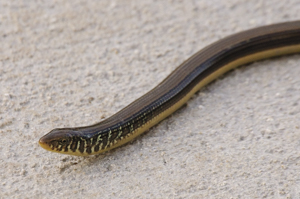
A slender, legless, brown, lizard to about 23 inches in length, with a dark stripe down each side just above a lateral groove. Superficially resembling a snake it is often referred to as a "Glass snake" because their tails can break off as a defense mechanism, while the detached tail wiggles to distract a predator the lizard makes its escape!
These lizards are unlike snakes in that they have external ear openings and movable eyelids that snakes do not have. Also, their jaws do not expand as a snakes does thus they cannot eat prey larger than their heads. Diet, as with most lizards consists of insects, spiders and other small invertebrates
As the name implies these lizards are found on offshore islands where they prefer grassy areas of the secondary dunes, mainland individuals find suitable habitat in pine forests and savannas with dense grassy ground cover.
Brown Basilisk - Basiliscus vittatus
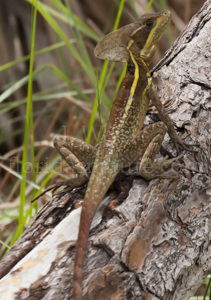
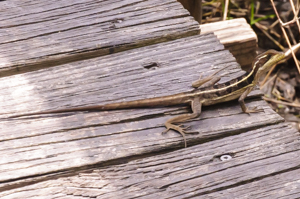
Invasive / Exotic
Brown to olive brown lizard with black cross-bands, a white to yellow stripe from the eye to the back legs, yellow/white markings on lower jaw and snout extending down to front legs sometimes to back legs gradually fading out, males of this species reach 24 inches in length and have large prominent crests on their head and backs, females are smaller with a smaller crest.
These lizards are very shy, running quickly away from human approach. They have the ability to run on water for short distances giving them the moniker "Jesus lizard". Native to Latin America from Central Mexico southward to northern Colombia. Diet is mostly insects but reportedly will sometimes feed on berries.
Tropical House Gecko - Hemidactylus mabouia

This lizard grows to about 5 inches long (including tail), with a neck that is narrower than their flat head, and while they have black bands on the body they also have the ability to change their color based on the temperature and light from dark brown to a grey almost white.
Their toes have spike-like scales and toenails that help the geckos grip onto vertical surfaces. Native to south-central region of Africa in the tropical forests and the shrub forests. In Florida they are present in a variety of habitats including scrubby and dry sandy areas as well as the walls and interior of human buildings.
They can often be seen near artificial light sources at night, hunting insects. During the day they like to shelter in a protected, dark place. Diet includes all types of insects, spiders,cockroaches, crickets and grasshoppers.
Argentine Black and White Tegu - Salvator merianae
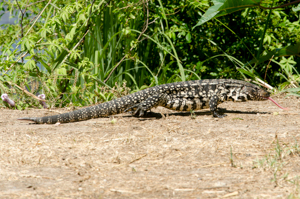
Invasive / Exotic
Imported through the pet trade from South America, tegus are not native to Florida - they are a prohibited species and illegal to posses without a state issued permit. These lizards can reach 4-5 feet long and weigh up to 10 pounds, they have a strong bite and will fight aggressively if cornered or threatened. Tegus are omnivores - they eat fruits, insects, small mammals, other lizards, the eggs of turtles, birds, alligators, and tortoises and will feed on carrion.
The Argentine Black and White Tegu has been found in 35 Florida counties and 4 Georgia counties, they are speckled black and white, often forming bands on the back, hatchlings have similar coloration with a green head, this green color fades after about ten months. Females build nests from vegetation and on average produce 35 eggs per year. Tegus avoid winter freezes by burrowing or using any available burrow.